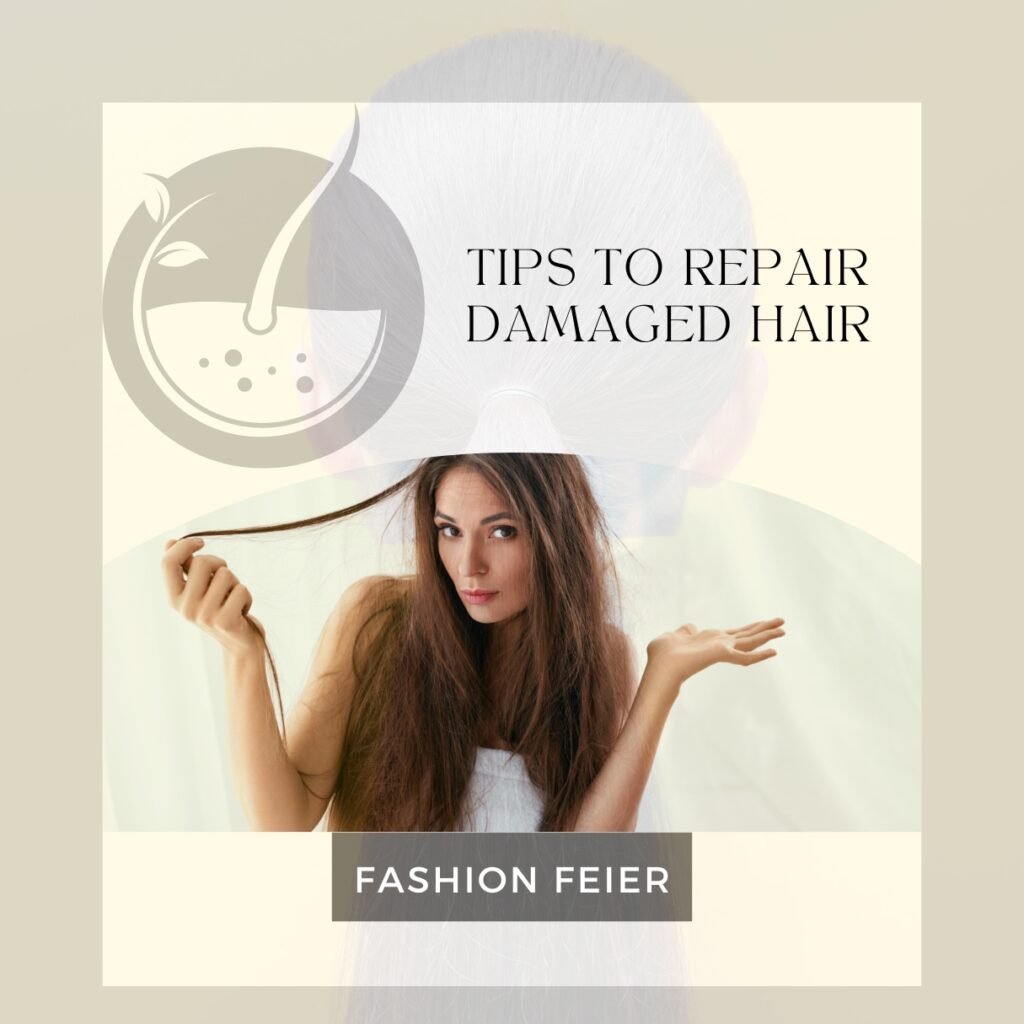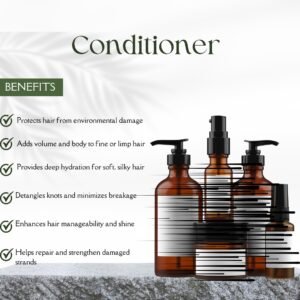Tips to Repair Damaged Hair: Essential Tips
Every strand of hair has its own story to tell, often one of damage and despair. Whether it’s from excessive styling, chemical treatments, or environmental stressors, damaged hair can be a source of frustration and self-consciousness. But fear not – with the right knowledge and care, you can restore your hair’s health and vitality. In comprehensive guide of Tips to Repair Damaged Hair, Fashion Feier will delve into a variety of effective Tips to Repair Damaged Hair, providing practical advice to help you achieve the luscious locks you deserve.
Hair isn’t just about appearances – it’s a reflection of our overall health and well-being. Just as we nourish our bodies with healthy habits, our hair requires proper care to thrive. Unfortunately, common practices like frequent heat styling and harsh chemical treatments can wreak havoc on our locks, leaving them dry, brittle, and prone to breakage. That’s where Tips to Repair Damaged Hair come in handy. By addressing the root causes of damage and adopting a holistic approach to hair care, you can set the stage for healthier, more resilient hair.
Repairing damaged hair is a journey that demands patience and dedication. From selecting the right hair care products to implementing healthy lifestyle changes, there are numerous strategies you can employ to nurse your hair back to health. By understanding what causes damage and taking proactive steps to prevent further harm, you can embark on the path to stronger, shinier hair. Throughout this guide with Fashion Feier, we’ll explore a variety of Tips to Repair Damaged Hair, empowering you to take control of your hair’s destiny and unlock its full potential.
In Detailed Tips to Repair Damaged Hair are Following:
Repairing damaged hair isn’t just about improving appearance – it’s about self-care and empowerment. As you incorporate these tips into your hair care routine, you’ll not only see physical changes in your locks but also experience a renewed sense of confidence. By prioritizing your hair’s health and showing it the love it deserves, you’ll pave the way for a brighter, more beautiful future. So, let’s dive into the world of hair repair and discover the transformative power of nurturing your strands back to health.
Identify the Underlying Cause of Damage: The first step in repairing damaged hair is to determine what’s causing the damage. Whether it’s frequent heat styling, chemical processing, or exposure to environmental stressors like pollution and UV rays, understanding the root cause will guide you in selecting appropriate treatments and preventive measures.
Select the Right Shampoo and Conditioner: Opt for mild, sulfate-free shampoos that cleanse the hair gently without stripping away its natural oils. Look for hydrating conditioners containing ingredients like argan oil, coconut oil, and shea butter to moisturize and nourish the hair. Focus on applying conditioner to the lengths and ends to prevent dryness and breakage. Explore Different Range
________________________________________________________________
Explore Different Range of Shampoo and Conditioner
Limit Heat Styling and Use Heat Protectants: Excessive heat styling can lead to significant hair damage, including dryness, breakage, and split ends. Minimize the use of hot tools such as flat irons, curling irons, and blow dryers, and always apply a heat protectant spray or serum before styling to shield the hair from thermal damage.
Protect Hair from UV Rays: Just like your skin, your hair can suffer damage from prolonged sun exposure. Shield your hair from harmful UV rays by wearing a hat or using hair care products with built-in UV protection. This helps prevent color fading, dryness, and weakening of the hair structure caused by sun damage.
Handle Wet Hair With Care: Wet hair is more susceptible to damage and breakage, so it’s important to handle it gently. Avoid rough towel-drying and instead, blot the excess moisture with a soft, microfiber towel. Use a wide-tooth comb to detangle the hair, starting from the ends and working your way up to the roots to minimize breakage.
Limit Chemical Treatments: Chemical processes such as coloring, bleaching, and perming can compromise the health of your hair, leading to damage and brittleness. Whenever possible, minimize the frequency of these treatments and opt for gentler alternatives. Consider using ammonia-free hair dyes and seek professional advice to ensure safe application and minimize damage.
Nourish Hair from Within: Healthy hair begins with a balanced diet rich in essential nutrients like vitamins, minerals, and proteins. Incorporate foods such as salmon, avocados, nuts, seeds, leafy greens, and fruits into your diet to promote hair health and growth from the inside out.
Stay Hydrated: Proper hydration is essential for maintaining healthy hair, as dehydration can lead to dryness and dullness. Drink an adequate amount of water throughout the day to keep your body and hair hydrated. Additionally, use hydrating hair masks or oil treatments regularly to lock in moisture and improve hair texture.
Regular Trims to Remove Split Ends: Regular trims are crucial for preventing split ends from worsening and traveling up the hair shaft. Aim to trim your hair every 6-8 weeks to remove damaged ends and promote healthy growth. Even if you’re growing out your hair, regular trims will improve its overall appearance and condition.
Incorporate Weekly Deep Conditioning Treatments: Treat your hair to weekly deep conditioning treatments to restore moisture and repair damage. Choose products enriched with ingredients such as keratin, silk proteins, and amino acids to strengthen the hair shaft and improve elasticity. Allow the deep conditioner to penetrate the hair for at least 30 minutes before rinsing thoroughly.
Conclusion: Tips to Repair Damaged Hair
Embarking on the journey to repair damaged hair requires a tailored approach and steadfast commitment. Throughout this comprehensive guide, we’ve explored a myriad of strategies to combat various hair woes, from dryness and breakage to split ends and lackluster appearance. By integrating these insights into your hair care regimen and prioritizing your hair’s well-being, you can transform your locks from distressed to resilient, radiating health and vitality.
Central to effective hair repair is the cultivation of a nurturing environment for your strands. Adopting gentle cleansing methods, opting for nourishing hair products free from harsh chemicals, and minimizing heat styling can help shield your hair from further damage. Additionally, incorporating regular deep conditioning treatments, protective styling, and making dietary adjustments can bolster your hair’s strength and resilience from within.
It’s essential to acknowledge that repairing damaged hair is a gradual process that demands patience and consistency. With each step forward in your hair care routine, you’re investing in the long-term health and beauty of your locks. By maintaining focus on your objectives and adhering to a diligent hair care regimen, you’ll soon begin to witness tangible improvements in your hair’s texture, strength, and overall condition.
As you embark on this transformative journey, remember to extend kindness and compassion to yourself. Celebrate the progress you make along the way, whether it’s embracing your natural hair texture, experimenting with new styles, or indulging in self-care rituals. Cultivating self-love and making informed choices about your hair care practices are fundamental aspects of promoting hair health and holistic well-being.
In closing, Fashion Feier trust this guide about “Tips to Repair Damaged Hair” has equipped you with valuable insights and inspiration to navigate your quest for healthier, more resilient hair. By incorporating the tips and techniques outlined here into your daily routine and maintaining steadfast dedication to your hair care goals, you’re poised to unlock the full potential of your locks. Remember, with patience, perseverance, and a touch of self-love, you can restore damaged hair to its former glory and embrace the beauty of your natural tresses.
FAQ About Tips to Repair Damaged Hair
Yes, damaged hair can be repaired with proper care and treatment. While some damage may be irreversible, adopting a consistent hair care routine that includes nourishing treatments, gentle styling practices, and regular trims can help restore the health and vitality of your hair over time.
There are several ways to repair damaged hair at home, including: Using gentle sulfate-free shampoos and moisturizing conditioners, Limiting heat styling and using heat-protectant products, Deep conditioning regularly with nourishing masks or oils, Trimming regularly to remove split ends and prevent further damage, Avoiding over-brushing and using a wide-tooth comb on wet hair, Protecting hair from environmental damage with hats or UV-protectant products, Eating a balanced diet rich in vitamins and minerals for hair health, Staying hydrated by drinking plenty of water.
While damaged hair cannot be regrown, you can promote healthy hair growth by: Using hair regrowth treatments like minoxidil, Avoiding heat styling and harsh chemicals, Nourishing hair with a balanced diet and supplements, Massaging the scalp to stimulate circulation, Trimming regularly to remove split ends and promote growth, and protecting hair from environmental damage.
Yes, cutting damaged hair is often necessary to remove split ends and prevent further breakage. Regular trims can promote healthier hair growth and improve overall hair appearance. However, the extent of cutting depends on the severity of the damage. Consulting with a professional hairstylist can help determine the best course of action for your specific hair condition.
Yes, damaged hair can still grow, but its growth may be compromised due to factors such as breakage and split ends. Damaged hair tends to be weaker and more prone to breakage, which can hinder its ability to grow longer. However, by implementing proper hair care practices and addressing the underlying causes of damage, such as excessive heat styling or chemical treatments, it's possible to support healthier hair growth over time. Regular trims to remove split ends and nourishing treatments can help promote stronger, longer hair growth. Can damaged hair be repaired?
How can I repair my damaged hair at home?
How can I regrow my damaged hair?
Should I cut my damaged hair?
Does damaged hair still grow?


